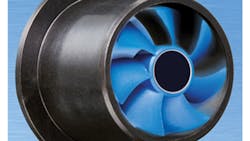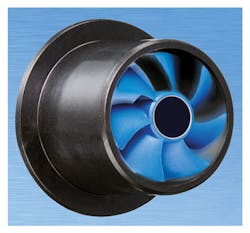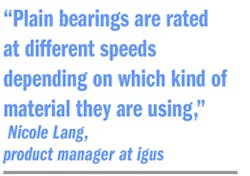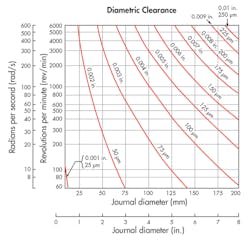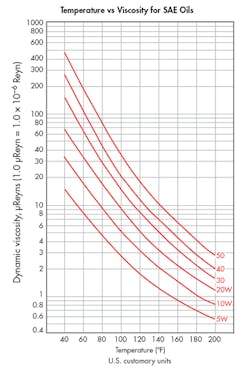Where there are moving parts, you’ll often find bearings. The goal of a bearing, in short, is to affect the system as minimally as possible—absorb minimal energy, wear slowly, and cost as little as possible. Bearings come in many flavors. This article will focus on plain bearings, and five factors that will play a role in selecting the right one for an application (also see "Sidebar: Rules of Thumb" at bottom of article).
The plain bearing has many names; often engineers will use plain, journal, sleeve, bushing, and slide bearings interchangeably. These types of bearings can be as simple as a tube of relatively soft material pressed into a hole as a guidepost, or used as a caster bearing (a metal sleeve with a wheel or ball inserted).
Sleeve-type bearings, which typically work in a rotating or sliding shaft application, are commonly known for linear motion almost as much as rotary motion, according to Thomasnet.com, a product sourcing and supplier platform. These bearings come in two types: a cylinder that mounts flush and only handles rotary loads, and a “flanged bearing” that helps a flange with axial loads.
Simply adding a feature, such as a flange, to your design can inflate cost. However, not adding a needed feature could lead to failure. That said, the first step to pinpointing the right plain bearing is to evaluate how and where it’s used.
What is the Application?
“The selection of journal bearings always begins with a thorough evaluation of the intended usage of the device containing the bearings,” says Gary Rosengren, director of engineering at Tolomatic Inc., a company that must select the right journal bearing for its electric actuators. “Proper selections include an evaluation of environmental factors such as aggressive chemicals, contamination, high or low operating temperatures, and/or wash-down requirements that may be present in food and beverage applications. Each application will suggest specific materials for optimal performance. Further application evaluation should focus on the type of loading the journal bearing will be subjected to. High rotational speeds, high linear velocities, or the presence of impact loading will also have an influence on the materials used for journal bearings.”
For example, high-speed applications such as centrifugal pumps, turbines, and compressor applications typically will not use ball bearings above 3600 rpm. This is one of the reasons why high-speed precision rotary equipment in the gas and oil industry uses plain bearings.
“After I have a conversation about how a bearing is going to be used, then I get into speeds, loads, tolerances, clearances, etc.” says Nicole Lang, product manager at igus, a plain bearing manufacturer. “A particular importance in all applications is the relationship between pressure and velocity (pV).”
Know Your pV Value
The pV value—the pressure (p) multiplied by the speed of operation (V)—measures the ability of the bearing material to accommodate the temperature limit generated by the frictional energy during operation. The pV value alone is only one-half of what is needed to achieve a stable temperature limit. Therefore, the solution pV will be multiplied by two for a design pV value before comparing with a material’s pV rating. Pressure is expressed as:
p = F/LD
where F = load/force; L = length; and D = diameter of journal.
The journal is the area of the shaft that operates inside the bearing. Journal speed would multiply pi with the given speed of the shaft (n) and the estimated diameter (D) divided by 60,000:
V = πDn/(60,000)
After solving for bearing pressure and velocity, they are multiplied together to obtain the pV factor. Materials with a rating above the doubled pV factor—known as the design pV value—are applicable.
Bearing diameter is often limited by stress and deflection, so the length is specified to provide a suitable bearing pressure. A trial diameter is selected that will then determine a trial length based on a desired length-to-diameter (L/D) ratio. For a full-film hydrodynamic bearing (explained later in this article), a common range for a length-to-diameter ratio is 0.35 to 1.5.
While this basic pV value can reveal the applicability of certain materials, it is important to consider different conditions, or understand different conditions that might alter design. For example, if the material’s pV rating is close to the calculated design pV value, thermal expansion of the selected materials will become increasingly important.
Know Your Diametral Clearance
The coefficient of thermal expansion, precision of the machine, rotation speed, and the shaft’s surface roughness all play a part to ensure the diametral clearance is satisfactory during operation. The minimum diametric clearance can be found from charts, or calculations.
“Typically, for our plastic bearings, a running clearance will be around 0.002 to 0.004 inches,” says Lang. “Housing bore and shaft tolerance will also have to be considered, and it is possible to have tighter clearances.”
Another guideline, referenced in Machine Elements in Mechanical Design by Robert L. Mott, is that clearance can be 0.001 to 0.002 times the bearing’s diameter. Engineers might also want to ask about how swelling will affect clearances in plastic bearings in humid or underwater applications.
With the information gathered thus far, it is probably a good time to look for bearing manufacturers to talk about your application. Some online manufacturers offer online calculators that might suggest a material or even a product. However, with application information, a pV factor, and diametral clearance, you have enough information to start a conversation with someone in the field. Speaking with manufacturers will help inform you of new materials, and other material properties that are not covered, or only briefly covered, in this article. After considering the application and basic properties, the focus can shift to the material.
Materials
In general, journal bearings are considered a sacrificial material, which means the material will be softer than the shaft. In addition, contamination can increase wear on a shaft. If the lubrication is insufficient in clearing contaminants, or it is a dry bearing application, having the contamination become embedded into a softer material can minimize wear. However, the softer the material, the more load and speed become a concern.
Babbitt material, named after metalsmith Isaac Babbitt, is a soft alloy normally made from lead or tin. Able to blend with other metals, such as copper, it is possible to tailor Babbitt materials for a specific application. Greater softness of a given material generally means that it will be more effective in terms of embeddability. Unfortunately, it also typically means the material has lower strength. Babbitt materials are often used as liners for steel or cast-iron housings, and are regularly used in engines for crankshafts.
Bronze is a blend, like Babbitt material. While metals like zinc and lead are added to reduce hardness, tin and aluminum can be added to improve the strength and hardness. Aluminum works well in pumps and aircraft applications, but due to poor embeddability, it needs to have continuous lubrication. Zinc is able to run without a continuous supply of lubrication—bearing grease is often used. While zinc protects well, it isn’t very effective in corrosive environments like salt or sea water. Overall, bronze will handle loads from around 25,000 to 40,000 psi in oscillating, or rotary, applications.
Load and speed will be the main determining factors in material selection, particularly for Babbitt and bronze. For example, a Babbitted sleeve bearing with a 1-in. diameter, operating at 200 rpm, will have a load rating of 270 lbs. Under the same conditions, a bronze sleeve bearing is rated at 470 lbs.
Other considerations for materials are corrosive or wash-down environments. Plastics and composite bearings have advanced to the point where they often are a good solution for these types of environments. It can be difficult to characterize plastic and composite bearings due to blends, fillers, and reinforcing matrix materials. Different blends are able to perform well in corrosive, humid, and even in underwater applications.
Another benefit of plastic bearings is their higher modulus of elasticity that works well for vibration damping and shock loads. While strength is a concern, plastics can handle surface pressure of a few thousand psi with relative ease. “There are a few plastics that can handle over 20,000 psi,” says igus’ Lang. “Metal-backed bearings can even handle upwards of 29,000 psi, but generally plastic will be used in applications under 20,000 psi.”
“A big benefit to using plastic bearings is that the fiber-reinforced material blends are tailored to specific application requirements, helping bearings stand up to shock and edge loads,” continues Lang. “In addition, swapping metallic plastic bushings to composite plastic bushings can reduce weight by 25% or more.”
Plastics are generally cost-effective, easy to process, and can offer pre-impregnated (prepreg) polymers. Prepreg bronze bearings are also available and draw oil from the bearing as it warms up. At low speeds, or during a cold start, the prepreg oil may have dried or solidified. This increases coefficient of friction and wear during startup. Some plastics such as fluoropolymers offer a low coefficient of friction (0.05 to 0.15) and wear resistance without oil.
Like plastic, metal bearings can offer custom blends and prepreg options when using a powdered-metallurgy (PM) process. PM offers easy custom alloying and good dimensional tolerances. Lubrication is key in journal bearings. Many applications that don’t use prepreg options employ hydrodynamic lubrication, whereby the shaft will ride on a layer of continuously flowing lubricant. Often speeds at least above a few hundred rpm are needed to pump oil and contaminants through the bearing.
Lubrication
One of the disadvantages of some plain bearings is the need for a continuous supply of lubricant. This could entail a pump, controls, piping, and other components that increase cost and complexity. Hydrostatic bearings offer an alternative with non-flowing lubrication that is often pressurized and held in with seals.
With the high levels of friction and temperature associated with journal bearings, hydrodynamic lubricant systems are able to control temperature of the lubricant, bearing, and shaft (some systems may include a heat exchanger or chiller for the oil). While hydrodynamic lubrication is common, the application and load is important. If the machine will experience a lot of starting and stopping, it’s important to keep in mind that the shaft will rest on the bearing when stopped. Kinetic coefficient of friction between the materials will affect wear during startup.
Petroleum oils are often designed to operate around, or under, 160ËF to combat oxidation. However, one of the biggest reasons for temperature control of lubricants concerns viscosity. Dynamic viscosity is imperative to bearing performance, and it changes with temperature. Viscosity is expressed in lb*s/in.2 (knows as a Reyn, named after Osborne Reynold for his significant work in fluid flow) or Pa*s in SI units. Some engineers will express it in centipoise.
1.0 lb*s/in2 = 6895 Pa*s
1.0 Pa*s = 1000 centipoise
The shaft’s surface roughness, and the minimum film thickness, will also affect lubrication. An average surface roughness of 16 to 32 microinches is acceptable for good bearing quality. In general, the bearing’s surface roughness should match the shaft. However, if the bearing material is softer than the shaft, the shaft will “wear in” the bearing. With some materials, especially plastic, this may be beneficial. The particles of the bearing that are ground off can fill valleys in the journal; essentially making the shaft smoother over time.
Hydrodynamic lubricated bearings are designed with a minimum film thickness that is affected by the surface roughness of the shaft. During standard operating conditions, the film of lubricant must ensure that no solid contact exists between the rotating shaft and bearing. Generally, a reduced surface roughness on the journal will reduce the minimum film thickness. However, the calculation for minimum film thickness does not account for the surface roughness. For ground journals, a common calculation only considers the journal’s diameter:
ho = 0.00025D
where D = journal diameter.
If anything during operation affects this minimum thickness, asperities on the journal and bearing will start to make contact and break. This will accelerate wear, as the asperities will aggregate if they aren’t flushed out of the system with a consistent flow of lubricant. If the lubricant is going to be reused, and often is, a filtration process must be added into the system.
Conclusion
Overall, the simplicity, cost, ease of manufacturing, and ease of maintenance keeps plain bearings in use in a wide range of applications. “A couple of tips—split bearings are good for applications that need maintenance; and for high-strength plastic bearings, pay attention to press fit bearings and housing materials,” says igus’ Lang. “Strong plastics rated bearings to be press fit in a steel housing, may push out aluminum housings. This might affect the final internal diameter of the bearing.”
The article offers a few simple tips that online tools, calculators, or apps might not tell you. While a good start, they will not replace the advice obtained from talking to a manufacture or other experts in the field when selecting a bearing for your application.
Sidebar: Rules of Thumb
What should engineers be asking, or focusing on, when looking for the right bearings?
Nicole Lang, igus: The main question should be: “What is the most cost-effective bearing that will suit my application’s specific requirements?” The requirements of the application at hand will really drive the selection process of a bearing.
Gary Rosengren, Tolomatic: Evaluate each application and select proper “size” bearings based on loading requirements. Evaluate each application and select proper “type” bearing based on load and cost objectives. Evaluate each application and select proper bearing “material” based on environmental requirements. Use good engineering practices to apply journal bearings and adhere to manufacturers suggestions regarding mounting tolerances.
